
THE future hope of an “era of peace” based on the “thousand years” that follow the death of Antichrist, according to the the book of Revelation, may sound like a new concept to some readers. To others, it is considered a heresy. But it is neither. The fact is, the eschatological hope of a “period” of peace and justice, of a “Sabbath rest” for the Church before the end of time, does have its basis in Sacred Tradition. In reality, it has been somewhat buried in centuries of misinterpretation, unwarranted attacks, and speculative theology that continues to this day. In this writing, we look at the question of exactly how “the era was lost”—a bit of a soap opera in itself—and other questions such as whether it is literally a “thousand years,” whether Christ will be visibly present at that time, and what we can expect. Why is this important? Because it not only confirms a future hope that the Blessed Mother announced as imminent at Fatima, but of events that must take place at the end of this age that will change the world forever… events that appear to be on the very threshold of our times.
THE PROPHESY… THE HERESIES
In Pentecost and the Illumination, I gave a simple chronology according to Scripture and the Church Fathers of how the end times unfolds. Essentially, before the end of the world:
-
Antichrist arises but is defeated by Christ and thrown into hell. [1]Rev 19:20
-
Satan is chained for a “thousand years,” while the saints reign after a “first resurrection.” [2]Rev 20:12
-
After that period of time, Satan is released, who then makes one last assault upon the Church. [3]Rev 20:7
-
But fire falls from heaven and consumes the devil who is thrown “into the pool of fire” where “the beast and the false prophet were.” [4]Rev 20:9-10
-
Jesus returns in glory to receive His Church, the dead are raised and judged according to their deeds, fire falls and a New Heavens and a New Earth are made, inaugurating eternity. [5]Rev 20:11-21:2
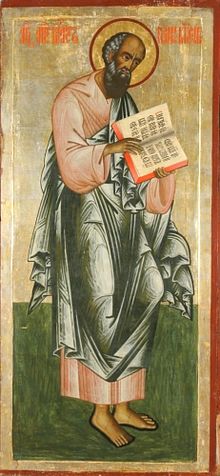 Thus, after the Antichrist and before the end of time, there is an intermittent period, a “thousand years,” according to St. John’s “Revelation” that he received on Patmos island.
Thus, after the Antichrist and before the end of time, there is an intermittent period, a “thousand years,” according to St. John’s “Revelation” that he received on Patmos island.
From the very beginning, however, what this period of a “thousand years” meant was quickly distorted by some Christians, particuarly Jewish converts who had been expecting an earthly Messiah. They took this prophecy to mean that Jesus would return in the flesh to reign on the earth for a literal period of a thousand years. However, this is not what John or the other Apostles taught, and thus these ideas were condemned as a heresy under the title Chiliasm [6]from the Greek, kiliàs, or 1000 or millenarianism. [7]from the Latin, mille, or 1000 As time carried on, these heresies mutated into others such as carnal millenarianism whose adherents believed that there would be an earthly kingdom punctuated by lavish feasts and carnal banquets lasting for a literal thousand years. Montanists (Montanism) held the belief that the millenary kingdom had already begun and that the New Jerusalem had already descended. [8]cf. Rev 21:10 In the 16th century, Protestant versions of millenarianism also spread while still other Catholic circles began to espouse mitigated or modified forms of millenarianism that dispensed with the carnal banquets, but still held that Christ would return to reign visibly in the flesh for a literal thousand years. [9]Source: The Triumph of God’s Kingdom in the Millenium and End Times, Rev. Jospeh Iannuzzi, OSJ, pp. 70-73
The Catholic Church, though, was consistent in warning of these heretical fires whenever they were lit, denouncing any notion that Christ would come again within human history to reign visibly in the flesh on earth, and for a literal thousand years at that.
The Antichrist’s deception already begins to take shape in the world every time the claim is made to realize within history that messianic hope which can only be realized beyond history through the eschatological judgment. The Church has rejected even modified forms of this falsification of the kingdom to come under the name of millenarianism, especially the “intrinsically perverse” political form of a secular messianism. —Catechism of the Catholic Church, n. 676
What the Magisterium hasn’t condemned, however, is the possibility of a temporal kingdom whereby Christ reigns spiritually from above for a triumphant period of time symbolized by the number of “a thousand years,” when Satan is chained in the abyss, and the Church enjoys a “Sabbath rest.” When this question was put to Cardinal Ratzinger (Pope Benedict XVI) when he was head of the Congregation for the Doctrine of the Faith, he responsed:
The Holy See has not yet made any definitive pronouncement in this regard. —Il Segno del Soprannauturale, Udine, Italia, n. 30, p. 10, Ott. 1990; Fr. Martino Penasa presented this question of a “millenary reign” to Cardinal Ratzinger
And hence, we turn then to the Fathers of the Church, those…
…towering intellects of the early centuries of the Church, whose writings, sermons and holy lives influenced dramatically the definition, defense and propagation of the Faith. —Catholic Encyclopedia, Sunday Visitor Publications, 1991, p. 399
For, as St. Vincent of Lerins wrote…
… if some new question should arise on which no such decision has been
given, they should then have recourse to the opinions of the holy Fathers, of those at least, who, each in his own time and place, remaining in the unity of communion and of the faith, were accepted as approved masters; and whatsoever these may be found to have held, with one mind and with one consent, this ought to be accounted the true and Catholic doctrine of the Church, without any doubt or scruple.. —Commonitory of 434 A.D., “For the Antiquity and Universality of the Catholic Faith Against the Profane Novelties of All Heresies”, Ch. 29, n. 77
WHAT THEY SAID…
There was a consistent voice among the Church Fathers regarding the “millennium”, a teaching which they affirmed was transmitted from the Apostles themselves and prophesied in the Sacred Scriptures. Their teaching was as follows:
1. The Fathers divided history into seven thousand years, symbolic of the seven days of creation. Catholic and Protestant Scripture scholars alike date the creation of Adam and Eve around 4000 B.C.
But do not ignore this one fact, beloved, that with the Lord one day is like a thousand years and a thousand years like one day. (2 Pet 3:8)
…this day of ours, which is bounded by the rising and the setting of the sun, is a representation of that great day to which the circuit of a thousand years affixes its limits. —Lactantius, Fathers of the Church: The Divine Institutes, Book VII, Chapter 14, Catholic Encyclopedia; www.newadvent.org
They foresaw, in the pattern of the Creator and creation, that after the “sixth day”, that is, the “six thousandth year,” there would be a “Sabbath rest” for the Church—a seventh day before the final and eternal “eighth” day.
And God rested on the seventh day from all his works… Therefore, a sabbath rest still remains for the people of God. (Heb 4:4, 9)
…when His Son will come and destroy the time of the lawless one and judge the godless, and change the sun and the moon and the stars—then He shall indeed rest on the seventh day… after giving rest to all things, I will make the beginning of the eighth day, that is, the beginning of another world. —Letter of Barnabas (70-79 A.D.), written by a second century Apostolic Father
…as if it were a fit thing that the saints should thus enjoy a kind of Sabbath-rest during that period, a holy leisure after the labors of six thousand years since man was created… (and) there should follow on the completion of six thousand years, as of six days, a kind of seventh-day Sabbath in the succeeding thousand years… And this opinion would not be objectionable, if it were believed that the joys of the saints, in that Sabbath, shall be spiritual, and consequent on the presence of God… —St. Augustine of Hippo (354-430 A.D.; Church Doctor), De Civitate Dei, Bk. XX, Ch. 7, Catholic University of America Press
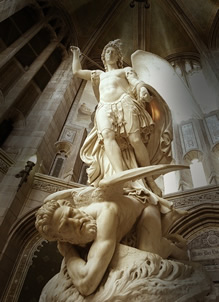 2. Following St. John’s teaching, they believed that all wickedness would be purged from the earth and that Satan would be chained during this seventh day.
2. Following St. John’s teaching, they believed that all wickedness would be purged from the earth and that Satan would be chained during this seventh day.
Also the prince of devils, who is the contriver of all evils, shall be bound with chains, and shall be imprisoned during the thousand years of the heavenly rule… —4th century Ecclesiastical writer, Lactantius, “The Divine Institutes”, The ante-Nicene Fathers, Vol 7, p. 211
3. There would be a “first resurrection” of the saints and martyrs.
I and every other orthodox Christian feel certain that there will be a resurrection of the flesh followed by a thousand years in a rebuilt, embellished, and enlarged city of Jerusalem, as was announced by the Prophets Ezekiel, Isaias and others… A man among us named John, one of Christ’s Apostles, received and foretold that the followers of Christ would dwell in Jerusalem for a thousand years, and that afterwards the universal and,
in short, everlasting resurrection and judgment would take place. —St. Justin Martyr, Dialogue with Trypho, Ch. 81, The Fathers of the Church, Christian Heritage
We do confess that a kingdom is promised to us upon the earth, although before heaven, only in another state of existence; inasmuch as it will be after the resurrection for a thousand years in the divinely-built city of Jerusalem… We say that this city has been provided by God for receiving the saints on their resurrection, and refreshing them with the abundance of all really spiritual blessings, as a recompense for those which we have either despised or lost… —Tertullian (155–240 A.D.), Nicene Church Father; Adversus Marcion, Ante-Nicene Fathers, Henrickson Publishers, 1995, Vol. 3, pp. 342-343)
Therefore, the Son of the most high and mighty God… shall have destroyed unrighteousness, and executed His great judgment, and shall have recalled to life the righteous, who… will be engaged among men a thousand years, and will rule them with most just command… —Lactantius, The Divine Institutes, The ante-Nicene Fathers, Vol 7, p. 211
So, the blessing foretold undoubtedly refers to the time of His Kingdom, when the just will rule on rising from the dead; when creation, reborn and freed from bondage, will yield an abundance of foods of all kinds from the heaven’s dew and the fertility of the earth, just as the seniors recall. Those who saw John, the Lord’s disciple, [tell us] that they heard from him how the Lord taught and spoke about these times… —St. Irenaeus of Lyons, Church Father (140–202 A.D.); Adversus Haereses, Irenaeus of Lyons, V.33.3.4, The Fathers of the Church, CIMA Publishing
4. Confirming the Old Testament prophets, they said this period would coincide with a restoration of creation whereby it would be pacified and renewed and that man would live out his years. Speaking in the same symbolic language of Isaiah, Lactantius wrote:
The earth will open its fruitfulness and bring forth most abundant fruits of its own accord; the rocky mountains shall drip with honey; streams of wine shall run down, and rivers flow with milk; in short the world itself shall rejoice, and all nature exalt, being rescued and set free from the dominion of evil and impiety, and guilt and error. —Caecilius Firmianus Lactantius, The Divine Institutes
He shall strike the ruthless with the rod of his mouth, and with the breath of his lips he shall slay the wicked.
Justice shall be the band around his waist, and faithfulness a belt upon his hips. Then the wolf shall be a guest of the lamb, and the leopard shall lie down with the kid… There shall be no harm or ruin on all my holy mountain; for the earth shall be filled with knowledge of the LORD, as water covers the sea… On that day, The Lord shall again take it in hand to reclaim the remnant of his people (Isaiah 11:4-11)
It will not be a perfect world, since there will still be death and free will. But the power of sin and temptation will have been greatly diminished.
These are the words of Isaiah concerning the millennium: ‘For there will be a new heaven and a new earth, and the former will not be remembered nor come into their heart, but they will be glad and rejoice in these things, which I create… There shall no more be an infant of days there, nor an old man that shall not fill up his days; for the child shall die a hundred years old… For as the days of the tree of life, so shall be the days of My people, and the works of their hands shall be multiplied. My elect shall not labor in vain, nor bring forth children for a curse; for they shall be a righteous seed blessed by the Lord, and their posterity with them. —St. Justin Martyr, Dialogue with Trypho, Ch. 81, The Fathers of the Church, Christian Heritage; cf. Is 54:1
5. Time itself would be altered in some way (hence the reason it is not a literal “thousand years”).
Now… we understand that a period of one thousand years is indicated in symbolic language. —St. Justin Martyr, Dialogue with Trypho, Ch. 81, The Fathers of the Church, Christian Heritage
On the day of the great slaughter, when the towers fall,
the light of the moon will be like that of the sun and the light of the sun will be seven times greater (like the light of seven days). On the day the LORD binds up the wounds of his people, he will heal the bruises left by his blows. (Is 30:25-26)
The sun will become seven times brighter than it is now. —Caecilius Firmianus Lactantius, The Divine Institutes
As Augustine says, the last age of the world corresponds to the last stage of a man’s life, which does not last for a fixed number of years as the other stages do, but lasts sometimes as long as the others together, and even longer. Wherefore the last age of the world cannot be assigned a fixed number of years or generations. —St. Thomas Aquinas, Quaestiones Disputate, Vol. II De Potentia, Q. 5, n.5; www.dhspriory.org
6. This period would come to an end at the same time that Satan would be released from his prison resulting in the final consumation of all things.
Before the end of the thousand years the devil shall be loosed afresh and shall assemble all the pagan nations to make war against the holy city… “Then the last anger of God shall come upon the nations, and shall utterly destroy them” and the world shall go down in a great conflagration. —4th century Ecclesiastical writer, Lactantius, “The Divine Institutes”, The ante-Nicene Fathers, Vol 7, p. 211
We shall indeed be able to interpret the words, “The priest of God and of Christ shall reign with Him a thousand years; and when the thousand years shall be finished, Satan shall be loosed out of his prison;” for thus they signify that the reign of the saints and the bondage of the devil shall cease simultaneously… so in the end they shall go out who do not belong to Christ, but to that last Antichrist… —St. Augustine, The Anti-Nicene Fathers, City of God, Book XX, Chap. 13, 19
SO WHAT HAPPENED?
When one reads Catholic bible commentaries, encyclopedias, or other theological references, they almost universally condemn or dismiss any concept of a “millennial” period before the end of time, not admitting even the concept of a triumphant period of peace on earth in which “the Holy See has not yet made any definitive pronouncement in this regard.” That is, they reject that which even the Magisterium has not.
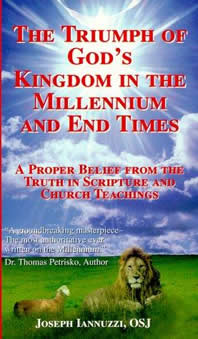 In his landmark research on this subject, theologian Fr. Joseph Iannuzzi writes in his book, The Triumph of God’s Kingdom in the Millennium and End Times, how the Church’s efforts to combat the heresy of Chiliasm often led to a “presumptuous approach” by critics regarding the sayings of the Fathers on the millennium, and that this has led to an “eventual falsification of those doctrines of the Apostolic Fathers.” [10]The Triumph of God’s Kingdom in the Millennium and End Times: A Proper Belief from the Truth in Scripture and Church Teachings, St. John the Evangelist Press, 1999, p.17.
In his landmark research on this subject, theologian Fr. Joseph Iannuzzi writes in his book, The Triumph of God’s Kingdom in the Millennium and End Times, how the Church’s efforts to combat the heresy of Chiliasm often led to a “presumptuous approach” by critics regarding the sayings of the Fathers on the millennium, and that this has led to an “eventual falsification of those doctrines of the Apostolic Fathers.” [10]The Triumph of God’s Kingdom in the Millennium and End Times: A Proper Belief from the Truth in Scripture and Church Teachings, St. John the Evangelist Press, 1999, p.17.
In examining the triumphant renewal of Christianity, many authors have assumed a scholastic style, and have cast shadows of doubt on the early writings of the Apostolic Fathers. Many have come close to labeling them as heretics, mistakenly comparing their “unmodified” doctrines on the millennium to those of the heretical sects. —Fr. Joseph Iannuzzi, The Triumph of God’s Kingdom in the Millennium and End Times: A Proper Belief from the Truth in Scripture and Church Teachings, St. John the Evangelist Press, 1999, p. 11
Most often, these critics base their position on the millennium on the writings of Church historian Eusebius of Caesarea (c. 260-c. 341 A.D.). He was and is considered a Father of Church history, and therefore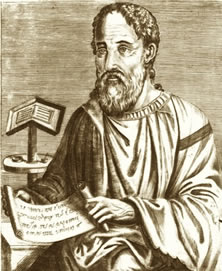 the “go to” source for many historical questions. But he was definitely not a theologian.
the “go to” source for many historical questions. But he was definitely not a theologian.
Eusebius himself became a victim of doctrinal errors and was, in fact, declared by Holy Mother Church a “schismatic”… he held arianistic views… he rejected the consubstantiality of the Father with the Son… he regarded the Holy Spirit as a creature (!); and… he condemned the veneration of images of Christ “so that we may not carry about our God in an image, like the pagans”. —Fr. Iannuzzi, Ibid., p. 19
Among the earliest writers on the “millennium” was St. Papias (c. 70-c. 145 A.D.) who was Bishop of Hierapolis and a martyr for his faith. Eusebius, who was a strong opponent of Chiliasm and thus of any concept of a millennium kingdom, seemed to go out of his way to attack Papias. St. Jerome wrote:
Eusebius… accused Papias of transmitting the heretical doctrine of Chiliasm to Irenaeus and other early churchmen. —New Catholic Encyclopedia, 1967, Vol. X, p. 979
In his own writings, Eusebius attempts to cast a shadow on Papias’ credibility when he wrote:
Papias himself, in the introduction to his books, makes it manifest that he was not himself a hearer and eye-witness of the holy apostles; but he tells us that he received the truths of our religion from those who were acquainted with them… —Church History, Book III, Ch. 39, n. 2
Yet, this is what St. Papias said:
I will not hesitate to add also for you to my interpretations what I formerly learned with care from the Presbyters and have carefully
stored in memory, giving assurance of its truth. For I did not take pleasure as the many do in those who speak much, but in those who teach what is true, nor in those who relate foreign precepts, but in those who relate the precepts which were given by the Lord to the faith and came down from the Truth itself. And also if any follower of the Presbyters happened to come, I would inquire for the sayings of the Presbyters, what Andrew said, or what Peter said, or what Philip or what Thomas or James or what John or Matthew or any other of the Lord’s disciples, and for the things which other of the Lord’s disciples, and for the things which Aristion and the Presbyter John, the disciples of the Lord, were saying. For I imagined that what was to be got from books was not so profitable to me as what came from the living and abiding voice. —Ibid. n. 3-4
Eusebius’ claim that Papias drew his doctrine from “acquaintances” instead of the Apostles is at best a “theory.” He speculates that by “Presbyters” Papias is referring to disciples and friends of the Apostles, even though Papias goes on to say that he was concerned with what the Apostles, “Andrew said, or what Peter said, or what Philip or what Thomas or James or what John or Matthew or any other of the Lord’s disciples…” However, not only did Church Father St. Ireneaus (c. 115-c. 200 A.D) employ the term “presbyteri” in referring to the Apostles, but St. Peter referred to himself in this way:
So I exhort the presbyters among you, as a fellow presbyter and witness to the sufferings of Christ and one who has a share in the glory to be revealed. (1 Pet 5:1)
Furthermore, St. Irenaeus wrote that Papias was “a hearer of [the Apostle] John, and companion of Polycarp, a man of old time.” [11]Catholic Encyclopedia, St. Papias, http://www.newadvent.org/cathen/11457c.htm On what authority does St. Irenaeus say this? In part, based on Papias’ own writings…
And these things are borne witness to in writing by Papias, the hearer of John, and a companion of Polycarp, in his fourth book; for there were five books compiled by him. —St. Irenaeus, Against Heresies, Book V, Chapter 33, n. 4
…and perhaps from St. Polycarp himself whom Irenaeus knew, and who was a disciple of St. John:
I am able to describe the very place in which the blessed Polycarp sat as
he discoursed, and his goings out and his comings in, and the manner of his life, and his physical appearance, and his discourses to the people, and the accounts which he gave of his intercourse with John and with the others who had seen the Lord. And as he remembered their words, and what he heard from them concerning the Lord, and concerning his miracles and his teaching, having received them from eyewitnesses of the ‘Word of life’, Polycarp related all things in harmony with the Scriptures. —St. Irenaeus, from Eusebius, Church History, Ch. 20, n.6
The Vatican’s own statement affirms Papias’s direct connection to the Apostle John:
Papias by name, of Herapolis, a disciple dear to John… copied the Gospel faithfully under John’s dictation. —Codex Vaticanus Alexandrinus, Nr. 14 Bibl. Lat. Opp. I., Romae, 1747, p.344
Making the assumption that Papias was propagating the heresy of Chiliasm rather than the truth of a temporal spiritual kingdom, Eusebius goes as far as to say that Papias is “a man of very little intelligence.” [12]The Faith of the Early Fathers, W.A. Jurgens, 1970, p. 294 What does that say then for Irenaeus, Justin Martyr, Lactantius, Augustine, and other Fathers of the Church who proposed that the “thousand years” refers to a temporal kingdom?
Indeed, the misappropriation of Papias’ doctrines to certain Jewish-Christian heresies of the past emerges precisely from such faulty opinion. Some theologians inadvertently adopted Eusebius’ speculative approach… Subsequently, these ideologues associated everything and anything that borders on a millennium with Chiliasm, resulting in an unhealed breach in the field of eschatololgy that would remain for a time, like an ubiquitous stricture, attached to the salient word millennium. —Fr. Joseph Iannuzzi, The Triumph of God’s Kingdom in the Millennium and End Times: A Proper Belief from the Truth in Scripture and Church Teachings, St. John the Evangelist Press, 1999, p. 20
TODAY
How does the Church today interpret the “thousand years” referred to by St. John? Again, she has made no definitive pronouncement in this regard. However, the interpretation given by the vast majority of theologians today, and for several centuries, is one of four that Church Doctor, St. Augustine of Hippo, proposed. He said…
…so far as occurs to me… [St. John] used the thousand years as an equivalent for the whole duration of this world, employing the number of perfection to mark the fullness of time. —St. Augustine of Hippo (354-430) A.D., De Civitate Dei “City of God”, Book 20, Ch. 7
However, the interpretation of Augustine most congruent with the early Church Fathers is this:
Those who on the strength of this passage [Rev 20:1-6], have suspected
that the first resurrection is future and bodily, have been moved, among other things, specially by the number of a thousand years, as if it were a fit thing that the saints should thus enjoy a kind of Sabbath-rest during that period, a holy leisure after the labors of six thousand years since man was created… (and) there should follow on the completion of six thousand years, as of six days, a kind of seventh-day Sabbath in the succeeding thousand years… And this opinion would not be objectionable, if it were believed that the joys of the saints, in that Sabbath, shall be spiritual, and consequent on the presence of God… —St. Augustine of Hippo (354-430 A.D),City of God, Bk. XX, Ch. 7
In fact, Augustine says “I myself, too, once held this opinion,” but seemingly put it on the bottom of the pile based on that fact that others in his time who held it went on to espouse that those “who then rise again shall enjoy the leisure of immoderate carnal banquets, furnished with an amount of meat and drink such as not only to shock the feeling of the temperate, but even to surpass the measure of credulity itself.” [13]City of God, Bk. XX, Ch. 7 And so Augustine—perhaps in response to the prevailing winds of millennial heresy—opted for an allegory that, although not unacceptable, was also an opinion “so far as occurs to me.”
All this said, the Church, while having not given explicit affirmation of the “thousand year” period to this point, has certainly done so implicitly…
IMPLICITLY
Fatima
Perhaps the most notable prophecy regarding a future Era of Peace is that of the Blessed Mother in the approved apparition of Fatima, where she says:
If my requests are heeded, Russia will be converted, and there will be peace; if not, she will spread her errors throughout the world, causing wars and persecutions of the Church. The good will be martyred; the Holy Father will have much to suffer; various nations will be annihilated. In the end, my Immaculate Heart will triumph. The Holy Father will consecrate Russia to me, and she shall be converted, and a period of peace will be granted to the world. —from the Vatican’s website: The Message of Fatima, www.vatican.va
The “errors” of Russia, which are atheistic-materialism, are indeed spreading “throughout the world”, as the Church was slow to respond to Our Lady’s “requests.” Ultimately, these errors will take  the form they did in Russia of global totalitarianism. I have explained, of course, in numerous writings here and in my book [14]The Final Confrontation why, based on the warnings of the popes, Our Lady’s apparitions, the Church Fathers, and the signs of the times, that we are at the end of this age and at the threshold of that “era of peace”, the last “thousand years”, the “sabbath rest” or “day of the Lord”:
the form they did in Russia of global totalitarianism. I have explained, of course, in numerous writings here and in my book [14]The Final Confrontation why, based on the warnings of the popes, Our Lady’s apparitions, the Church Fathers, and the signs of the times, that we are at the end of this age and at the threshold of that “era of peace”, the last “thousand years”, the “sabbath rest” or “day of the Lord”:
And God made in six days the works of His hands, and on the seventh day He ended… the Lord will make an end of everything in six thousand years. And He Himself is my witness, saying: “Behold the Day of the Lord shall be a thousand years.” —Epistle of Barnabas, written by a second century Apostolic Father, Ch. 15
The expectation, then, of a “period of peace” has been indirectly approved by the Church.
Family Catechism
There is a family catechism that was created by Jerry and Gwen Coniker called The Apostolate’s Family Catechism, which has been approved by the Vatican. [15]www.familyland.org The papal theologian for Pius XII, John XXIII, Paul VI, John Paul I, and John Paul II, wrote in a letter included in its introductory pages:
Yes, a miracle was promised at Fatima, the greatest miracle in the history of the world, second only to the Resurrection. And that miracle
will be an era of peace which has never really been granted before to the world. —Mario Luigi Cardinal Ciappi, October 9th, 1994; he also gave his stamp of approval in a separate letter officially recognizing the Family Catechism “as a sure source for authentic Catholic doctrine” (Sept. 9th, 1993); p. 35
On August 24th, 1989, in another letter, Cardinal Ciappi wrote:
The “Marian Era of Evangelization Campaign” can put into motion a chain of events to bring about that era of peace promised at Fatima. With His Holiness Pope John Paul, we look expectantly and prayerfully for this era to begin with the dawn of the third millennium, the year 2001. —The Apostolate’s Family Catechism, p. 34
Indeed, in reference to the millennium, Cardinal Joseph Ratzinger (Pope Benedict XVI) said:
And we hear today the groaning [of creation] as no one has ever heard it before… The Pope does indeed cherish a great expectation that the millennium of divisions will be followed by a millennium of unifications. He has in some sense the vision that… now, precisely at the end, we could rediscover a new unity through a great common reflection. —On the Threshold of a New Era, Cardinal Joseph Ratzinger, 1996, p. 231
Some Theologians
There are some theologians who have correctly understood the spiritual millennium to come, while acknowledging that its exact dimensions remain obscure, such as the renowned Jean Daniélou (1905-1974):
The essential affirmation is of an intermediate stage in which the risen saints are still on earth and have not yet entered their final stage, for this is one of the aspects of the mystery of the last days which has yet to be revealed. —A History of Early Christian Doctrine Before the Council of Nicea, 1964, p. 377
“…no new public revelation is to be expected before the glorious manifestation of our Lord Jesus Christ.” Yet even if Revelation is already complete, it has not been made completely explicit; it remains for Christian faith gradually to grasp its full significance over the course of the centuries. —Catechism of the Catholic Church, n. 66
The Teachings of the Catholic Church, published by a theological commission in 1952, concluded that it is not contrary to Catholic teaching to believe or 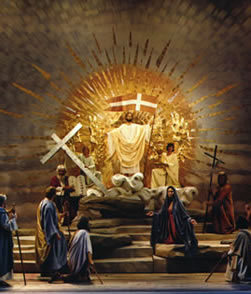 profess…
profess…
…a hope in some mighty triumph of Christ here on earth before the final consummation of all things. Such an occurrence is not excluded, is not impossible, it is not all certain that there will not be a prolonged period of triumphant Christianity before the end.
Steering clear of Chiliasm, they rightly conclude:
If before that final end there is to be a period, more or less prolonged, of triumphant sanctity, such a result will be brought about not by the apparition of the person of Christ in Majesty but by the operation of those powers of sanctification which are now at work, the Holy Ghost and the Sacraments of the Church. —The T eaching of the Catholic Church: A Summary of Catholic Doctrine (London: Burns Oates & Washbourne, 1952), p. 1140; cited in The Splendor of Creation, Rev. Joseph Iannuzzi, p. 54
Likewise, it is summed up in the Catholic Encyclopedia:
The more noteworthy of the prophecies bearing upon “latter times” seem to have one common end, to announce great calamities impending over mankind, the triumph of the Church, and the renovation of the world. —Catholic Encyclopedia, Prophecy, www.newadvent.org
Catechism of the Catholic Church
While not explicitly referring to the “thousand years” of St. John, the Catechism also echoes the Church Fathers and Scripture which speak of a renewal through the power of the Holy Spirit, a “new Pentecost”:
…at the “end time” the Lord’s Spirit will renew the hearts of men, engraving a new law in them. He will gather and reconcile the scattered and divided
peoples; he will transform the first creation, and God will dwell there with men in peace. —Catechism of the Catholic Church, n. 715
In these “end times,” ushered in by the Son’s redeeming Incarnation, the Spirit is revealed and given, recognized and welcomed as a person. Now can this divine plan, accomplished in Christ, the firstborn and head of the new creation, be embodied in mankind by the outpouring of the Spirit: as the Church, the communion of saints, the forgiveness of sins, the resurrection of the body, and the life everlasting. —Catechism of the Catholic Church, n. 686
Servant of God, Luisa Piccarreta (1865-1947)
Luisa Picarretta (1865-1947) is a remarkable “victim soul” to whom God revealed, in particular, the mystical union that He will bring to the Church during the “era of peace” that He has already begun to actualize in the souls of individuals. Her life was marked by astounding supernatural phenomena, such as being in a death-like state for days at a time while rapt in ecstasy with God. The Lord and 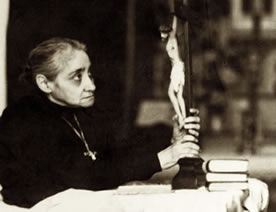 the Blessed Virgin Mary communicated with her, and these revelations were put into writings that focus primarily on “Living in the Divine Will.”
the Blessed Virgin Mary communicated with her, and these revelations were put into writings that focus primarily on “Living in the Divine Will.”
Luisa’s writings consist of 36 volumes, four publications, and numerous letters of correspondence that address the coming new epoch when the Kingdom of God will reign in an unprecedented way “on earth as it is in heaven.” In 2012, Rev. Joseph L. Iannuzzi presented the first doctoral dissertation on Luisa’s writings to the Pontifical University of Rome, and theologically explained their consistency with the historical Church Councils, as well as with patristic, scholastic and ressourcement theology. His dissertation received the Vatican University’s seals of approval as well as ecclesiastical approval.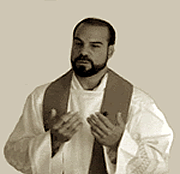 In January of 2013, Rev. Joseph presented an extract of the dissertation to the Vatican Congregations for the Causes of Saints and the Doctrine of Faith to help advance Luisa’s cause. He relayed to me that the congregations received them with great joy.
In January of 2013, Rev. Joseph presented an extract of the dissertation to the Vatican Congregations for the Causes of Saints and the Doctrine of Faith to help advance Luisa’s cause. He relayed to me that the congregations received them with great joy.
In one entry of her diaries, Jesus says to Luisa:
Ah, my daughter, the creature always races more into evil. How many machinations of ruin they are preparing! They will go so far as to exhaust themselves in evil. But while they occupy themselves in going their way, I will occupy Myself with the completion and fulfillment of My Fiat Voluntas Tua (“Thy will be done”) so that My Will reign on earth—but in an all-new manner. Ah yes, I want to confound man in Love! Therefore, be attentive. I want you with Me to prepare this Era of Celestial and Divine Love… —Jesus to Servant of God, Luisa Piccarreta, Manuscripts, Feb 8th, 1921; excerpt from The Splendor of Creation, Rev. Joseph Iannuzzi, p.80
…every day in the prayer of the Our Father we ask the Lord: “Thy will be done, on earth as it is in heaven” (Matthew 6:10)…. we recognize that “heaven” is where the will of God is done, and that “earth” becomes “heaven”—i.e., the place of the presence of love, of goodness, of truth and of divine beauty—only if on earth the will of God is done. —POPE BENEDICT XVI, General Audience, February 1st, 2012, Vatican City
Just as all men share in the disobedience of Adam, so all men must share in the obedience of Christ to the Father’s will. Redemption will be complete only when all men share his obedience. —Servant of God Fr. Walter Ciszek, He Leadeth Me, pg. 116, Ignatius Press
In Rev. Joseph’s dissertation, again, given explicit ecclesiastical approval, he quotes Jesus’ dialogue with Luisa regarding the dissemination of her writings:
The time in which these writings will be made known is relative to and dependent on the disposition of souls who wish to receive so great a good, as well as on the effort of those who must apply themselves in being its trumpet-bearers by offering up the sacrifice of heralding in the new era of peace… —The Gift of Living in the Divine Will in the Writings of Luisa Piccarreta, n. 1.11.6, Rev. Joseph Iannuzzi
St. Margaret Mary Alacoque (1647-1690)
In the ecclesially recognized apparitions of St. Margaret Mary, Jesus appeared to her revealing His Sacred Heart. She would echo ancient writer, Lactantius, regarding 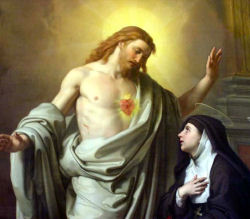 the end of Satan’s reign and the beginning of a new era:
the end of Satan’s reign and the beginning of a new era:
This devotion was the last effort of His love that He would grant to men in these latter ages, in order to withdraw them from the empire of Satan which He desired to destroy, and thus to introduce them into the sweet liberty of the rule of His love, which He wished to restore in the hearts of all those who should embrace this devotion. —St. Margaret Mary, www.sacredheartdevotion.com
The Modern Popes
Last, and most significantly, the popes of the past century have been praying for and prophesying of a coming “restoration” of the world in Christ. You can read their words in The Popes, and the Dawning Era and What If…?
Thus, with confidence, we can believe in the hope and possibility that this present time of distress among the nations will give way to a new era in which all of creation will proclaim that “Jesus is Lord.”
RELATED READING:
Millenarianism—What it is, and is Not
What if there is no era of peace? Read What If…?
The Coming of the Kingdom of God
The Coming Dominion of the Church
Your donation is greatly appreciated for this full time ministry!
Click below to translate this page into a different language:
Footnotes
| ↑1 | Rev 19:20 |
|---|---|
| ↑2 | Rev 20:12 |
| ↑3 | Rev 20:7 |
| ↑4 | Rev 20:9-10 |
| ↑5 | Rev 20:11-21:2 |
| ↑6 | from the Greek, kiliàs, or 1000 |
| ↑7 | from the Latin, mille, or 1000 |
| ↑8 | cf. Rev 21:10 |
| ↑9 | Source: The Triumph of God’s Kingdom in the Millenium and End Times, Rev. Jospeh Iannuzzi, OSJ, pp. 70-73 |
| ↑10 | The Triumph of God’s Kingdom in the Millennium and End Times: A Proper Belief from the Truth in Scripture and Church Teachings, St. John the Evangelist Press, 1999, p.17. |
| ↑11 | Catholic Encyclopedia, St. Papias, http://www.newadvent.org/cathen/11457c.htm |
| ↑12 | The Faith of the Early Fathers, W.A. Jurgens, 1970, p. 294 |
| ↑13 | City of God, Bk. XX, Ch. 7 |
| ↑14 | The Final Confrontation |
| ↑15 | www.familyland.org |


